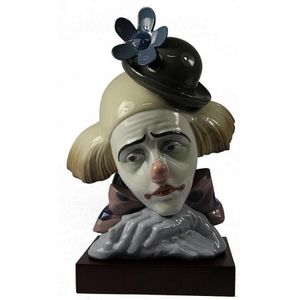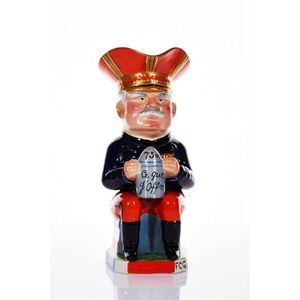Art Deco Josephine Baker-inspired Jars and Covers
You must be a subscriber, and be logged in to view price and dealer details.
Subscribe Now to view actual auction price for this item
When you subscribe, you have the option of setting the currency in which to display prices to $Au, $US, $NZ or Stg.
- Art Deco Period - The Art Deco period was a cultural movement that emerged in the 1920s and 1930s, and was characterized by its emphasis on modernism, luxury, and elegance. The name "Art Deco" comes from the Exposition Internationale des Arts Décoratifs et Industriels Modernes, a large exhibition held in Paris in 1925 that showcased the latest trends in decorative arts.
Art Deco was a reaction against the ornate and elaborate styles of the previous era, and reflected a new modern sensibility. It was characterized by streamlined, geometric shapes, bright colours, and the use of new materials such as chrome, glass, and Bakelite. Art Deco designers sought to create a sense of luxury and sophistication, often incorporating expensive materials such as ivory, marble, and rare woods.
Art Deco had a significant impact on a wide range of artistic fields, including architecture, fashion, graphic design, and interior design. Some of the most iconic examples of Art Deco architecture include the Empire State Building in New York City, the Hoover Building in London, and the Palais de Chaillot in Paris.
The Art Deco period came to an end in the 1940s, as World War II and changing cultural trends led to a shift in artistic styles. However, Art Deco remains an important influence on design and art, and continues to be celebrated for its modernist sensibility and glamorous aesthetic. - Important - Important is a word used in the antique trade to indicate an object should be ranked above other similar objects, and is therefore more valuable.
The object could be considered important because it is by a famous designer or maker, has been shown at a major exhibition, is of exquisite workmanship, is rare or is a "one-off", was made for an important patron, and so on.
Even further up the pecking order are objects that are described in catalogue descriptions as highly important or extraordinarily important.
This item has been included into following indexes:
Visually similar items

Lladro 'Clown's Head Bowler Hat' bust on a timber base. Issue year 1982, Retirement year 2001, sculptor, Jose Puche dimensions 28 x 18 cm

Sir Francis Carruthers Gould for Wilkinson, collection of Toby jugs of the Allied Commanders of the first World War, c. 1915-1919, ?Marshal Joffre', in uniform, holding a shell inscribed '75 mm Ce que J'Offre', ?Rt. Hon. David Lloyd George', holding a shel

Three Bing & Grondahl figurines, comprising of 2148, 2400 and 3556, 17.5 cm high (tallest), smallest repaired

A pair of Empire style enamel and ormolu candlesticks 18th / 19th century 17 cm high (each)
